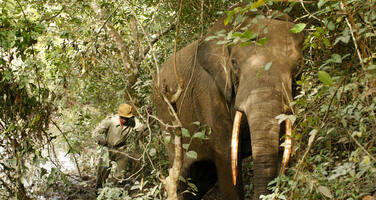Garamba National Park
Factors affecting the property in 1985*
- Illegal activities
Factors* affecting the property identified in previous reports
Poaching
International Assistance: requests for the property until 1985
Total amount approved : 104,120 USD
| 1985 | Equipment for the project to protect the rhinoceros ... (Approved) | 20,000 USD |
| 1985 | Contribution to the project for to rescue the white ... (Approved) | 25,000 USD |
| 1983 | Equipment for rescue programme for white rhino and ... (Approved) | 40,000 USD |
| 1980 | Equipment for Garamba National Park (Approved) | 19,120 USD |
Missions to the property until 1985**
Conservation issues presented to the World Heritage Committee in 1985
[Oral report]
The representative of Zaire, the President Delegate General of the Zaire Institute for the Conservation of Nature (IZCN), presented the Committee with an up-to-date report on the progress of work undertaken by IZCN and the consortium formed by Unesco-World Heritage, IUCN/WWF and the Frankfurt Zoological Society.
The main objective of the project is to safeguard the population of endangered northern white rhinoceros in the park.
The project was progressing well and the equipment provided with support of the World Heritage Fund had helped to strengthen the protection of this park. Indeed, there had been no deaths of rhinoceros reported since 1984 and two baby rhinoceroses had been born in May and June in 1985, bringing the population to 15 specimens.
The representative of Zaire stressed his Government's commitment to this project, which, in particular, would enable the rhinoceros population to build up its numbers in its natural habitat.
Analysis and Conclusion by World Heritage Centre and the Advisory Bodies in 1985
The Committee congratulated the Zairois authorities on their laudable efforts to ensure the success of this project and hoped that sufficient progress could eventually be made to remove Garamba National Park from the List of World Heritage in Danger.
Summary of the interventions
Decisions adopted by the Committee in 1985
9 COM XIII.A
SOC: Garamba National Park (Zaire)
Garamba National Park, Zaire: The representative of Zaire, the President Delegate General of the Zaire Institute for the Conservation of Nature (IZCN), presented the Committee with an up-to-date report on the progress of work undertaken by IZCN and the consortium formed by Unesco-World Heritage, IUCN/WWF and the Frankfurt Zoological Society. The main objective of the project is to safeguard the population of endangered northern white rhinoceros in the park. The project was progressing well and the equipment provided with support of the World Heritage Fund had helped to strengthen the protection of this park. Indeed, there had been no deaths of rhinoceros reported since 1984 and two baby rhinoceroses had been born in May and June in 1985, bringing the population to 15 specimens. The representative of Zaire stressed his Government's commitment to this project, which, in particular, would enable the rhinoceros population to build up its numbers in its natural habitat. The Committee congratulated the Zairois authorities on their laudable efforts to ensure the success of this project and hoped that sufficient progress could eventually be made to remove Garamba National Park from the List of World Heritage in Danger.
9 COM XIV.41
Requests for Technical Co-operation
41. The Committee approved two requests concerning properties inscribed on the List of World Heritage in Danger:
- Benin - Royal Palaces of Abomey: $20,000
- Zaire: Garamba National Park: $20,000
The Committee authorized the Bureau to approve an additional amount of $20,000 under technical cooperation for this property subject to the receipt of an appropriate request.
No draft decision proposed

Exports
* :
The threats indicated are listed in alphabetical order; their order does not constitute a classification according to the importance of their impact on the property.
Furthermore, they are presented irrespective of the type of threat faced by the property, i.e. with specific and proven imminent danger (“ascertained danger”) or with threats which could have deleterious effects on the property’s Outstanding Universal Value (“potential danger”).
** : All mission reports are not always available electronically.

